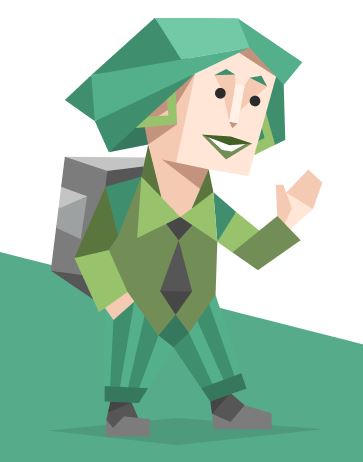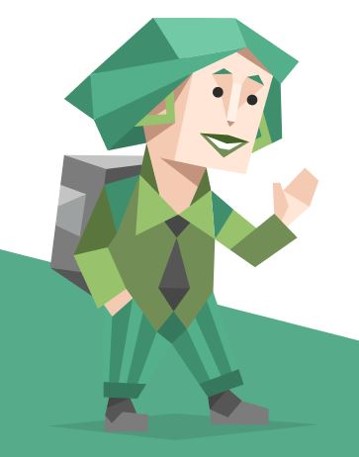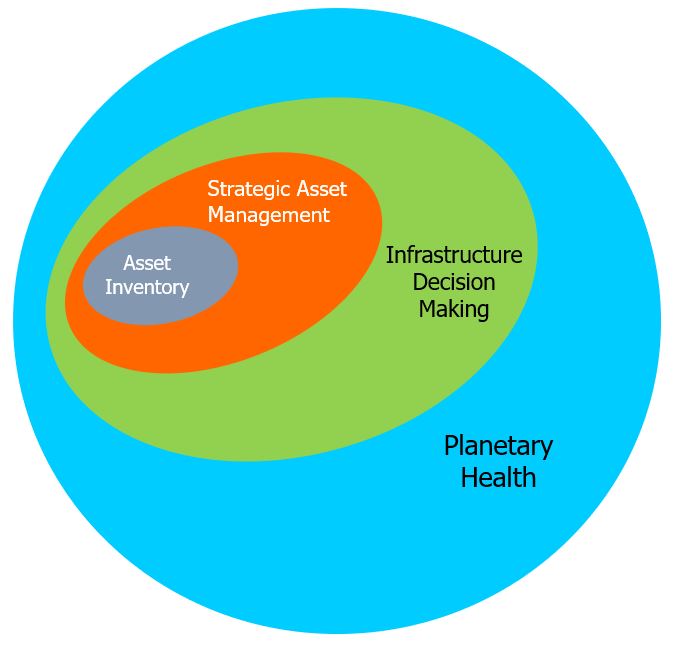
Almost 40 years ago I accidentally found myself asking how we could manage our assets better. It became an all absorbing passion, always changing, ever expanding. And now Talking Infrastructure is giving me the opportunity to tell my story in ‘Asset Management as a Quest‘, the first volume in what we plan to be a 4 volume study involving the stories of many leading practitioners over the last 4 decades.
We are producing it as a serial, which is appropriate, as you will see, for Asset Management itself developed as a serial, a bit at a time, over time. Available now are the first chapters of Volume 1 ( Asset Management as a Quest): Chapter 1 which looks at how an innocent remark by one led to a lifetime of inquiry by many, Chapter 2, where we realise we can actually foretell the future (well, at least a bit), and, added today, is Chapter 3 where we look at some of the initial reactions to the changes implied by those early stages of asset management.
Here is how Chapter 3 begins – but it is better to start at the beginning with Chapter 1.
“The right time and place“
Had I tried to do this exercise anywhere else than with the EWS, I am now convinced it would not have seen the light of day. I would have been blocked by those who foresaw their current situation changing, and changing in ways they could not control.
Chief amongst these was Finance, as was later to be confirmed by the reactions of the State Treasury. There really was nothing in this exercise for Finance. They were comfortable with the way things were, they knew what they were doing, and they had ‘the power of the purse’. What I was proposing was going to shake things up.
Finance has a short term focus, mostly concerned with this budget year and next year’s budget bid. Fortunately, in the EWS, engineers were dominant and they were able to take a longer term view. They were excited to realise that their asset portfolio was so big – and thus important! So, regardless of personalities, it was natural that I would get more support from engineering than from finance. But, of course, there was more involved. There always is.”
Aneurin Hughes, Cardno, asked me this question at AM Peak last week.
It got me thinking and I realised that I never had an expectation, or long term vision, and I still haven’t. If it was hard to see the future back then, it certainly hasn’t got any easier now.
And yet, without any formal long-term planning, we have made incredible strides. Which is what makes looking back to where we started so fascinating.
I had certain things I believed in – that we needed to know WHAT we were doing, WHY we were doing it, and how much it was COSTING us – for these were necessary to make sensible decisions. These were basic so I was surprised to find so little attention to them when it came to infrastructure.
Today these same questions still apply – but now we are able to tackle them in far greater depth and complexity. And I think that ability (and the desire to apply it) is what has changed the most over the last almost four decades. Once we thought of WHAT in simplistic physical and immediate terms, now it embraces the impact we have having on the environment and on society now and into the future. The WHY question which used to be ‘what’s in it for us’ where the ‘us’ was the supply organisation, now looks further and is forcing us to have a greater understanding of the role of infrastructure beyond its mere ‘job creation’ aspects, to consider the myriad ways in which infrastructure interacts with the way we ‘live, work and play’.
The question of COSTS is perhaps the most controversial one we are dealing with today. Initially we knew almost nothing and a lot of the early development of AM focused on understanding this better. At first we just looked to the financial cost to the supply organisation and ignored those external costs that fell on users, or on the community – both now and future. These are now, at least, being discussed, but we still have some way to go before we make the necessary institutional changes that will enable the issues being discussed to be implemented. In the meantime, so many incentives remain counter-productive.
So my answer to Aneurin was, of course, ‘No’, because I had no theoretical long term vision. Instead my approach to AM was more pragmatic, more incremental, I just tackled the next problem that I could see.
QUESTION: Do you have a vision? If so, what are the next steps on the way to achieving your vision?
We have uploaded Chapter Two of ‘Asset Management as a Quest’ today.
It is now almost 40 years since Asset Management started. To celebrate, Talking Infrastructure is producing a history of the development of our discipline, now a recognised industry and moreover one for which there is excess demand.
‘Asset Management as a Quest’ is the first in this four volume series and it covers the period from 1984 to 1993. While future volumes, each covering one decade, will call on the ideas, experience and stories from many leading practioners, the first volume is told by Dr Penny Burns, and it is the story through her eyes.
Part One, consisting of 4 chapters, was first published in July 2021. It is now revised and we will be presenting the whole volume, all 20 chapters, one chapter at a time each fortnight. You can find the first chapter, ‘How Asset Management Began’ here.
Information on how you can be part of Volumes 2-4 coming shortly – so, if you have not yet joined Talking Infrastructure (it’s free!) do so, and you will be the first to be advised.
“Like so many deeply involved in transportation issues, I greeted the (US) Infrastructure Investment and Jobs Act with great enthusiasm. However…”
Interesting article on why it’s unlikely the US road and transit sectors will make good use of a US $1.2 trillion windfall…
“So what should we do? For one, state departments of transportation (DOTs) and regional transit agencies should be required to build and maintain the strategic planning and analytical skills that will allow them to use these enhanced federal funding on the most necessary and beneficial projects.”
Yes, let’s!
Many thanks to Amy Lindblom for this link
And maybe good riddance to 2021, that groundhog year for many of us waking up every work day to trudge to our home office in our slippers and yet another Zoom/ Teams meeting.
In 2021 we celebrated five years of Talking Infrastructure, and Penny Burns’ 80th birthday. We began to publish The Story of Asset Management – and in 2022 we continue.
This year, we also want to build on the pioneering thinking at Blue Mountains City Council on infrastructure, biodiversity and planetary health.
And a follow-up to Building an Asset Management Team, this time aimed at CEOs, board and council members accountable for major infrastructure decisions. We’re looking at advocacy for future-friendly assets in the USA, as the Biden Infrastructure Bill proposes to invest billions of dollars in infrastructure.
All of these welcome your active involvement.
- What are good examples of truly environmentally friendly infrastructure assets that you know of?
- What are the right questions for decision-makers to ask before using ‘Build Back Better’ funding?
- How have you been involved in developing Asset Management in your country or state?
Get in touch to join these initiatives, and let’s make it a good year for infrastructure together.


How do we get AM into decisions and projects for new assets?
I fear we haven’t quite got there yet. The lure of shiny new things means that even in those organisations where Asset Management is almost business as usual… any thinking about the whole ‘lust to dust’ lifecycle management, even basic on-going costs, goes out the window as soon as opportunities to access money for new (such as Biden’s 2021 Infrastructure Plan) arise.
It’s almost as if organisations can tolerate Asset Management – as long it does not impinge on their fun.
And so we continue to build long-term liabilities.
Wave 3 is ensuring that Asset Management, and Asset Managers, have their seat at the top table in decisions about growth and shiny new things. And once we are there, to ask very hard questions about both of them.
I would like to explore how we get to be at that table, and that ‘future friendly assets’ start, but don’t end, with a healthy scepticism about building anything new.
- What are they really going to cost over their whole life?
- Who really benefits from them?
- What do we rule out by investing in them, as opposed to something else?
- And what might we actually destroy in the process?
How do we make sure we are at the table to be able to ask them?

For a longer article on what goes wrong when Asset Management is not on the table, please see:

An Asset Management friend recently emailed me that her CEO had challenged her view of the importance of AM to their whole business strategy. “So asset management is improving our passenger experience? Asset management is improving employee engagement? Asset management cures cancer?”
While, on the other hand, even plenty of people with ‘Asset Manager’ in their job title act like their job is to manage the list of assets in an IT system.
ISO 55000 makes bold claims, that I think it cannot substantiate. That the same principles we apply to managing physical assets hold true to managing anything else of value, like financial assets, or people. I suspect that the good folks who wrote ISO 55000 may have no idea what that even means – or, put it this way, would you necessarily go to an engineer to tell you how to manage people?
So I do in practice think there’s a limit.
However, managing physical assets clearly is a huge part of running an asset-intensive organisation such as transit or power, or even a city. It’s certainly most of their budget and resources. If you can get that right, many good things should follow, like profit, customer service and, yes, engaged workforce.
But perhaps the real point is that to manage the physical assets well, you have to think about profit, customer service, and engaged workers.
To me, it’s obvious that it matters – it matters hugely that we do manage our essential infrastructure well, that not merely our economy but quality of life and planetary health depend on it. So we need a wider vision, an understanding of interconnections and dependencies, ‘the bigger picture’.
Asset management will not cure cancer. It has boundaries.
But managing the physical assets that underpin our society effectively is probably wide enough scope to be getting on with, don’t you think?

Hedgerows in the Lincolnshire countryside near the small village of Aslackby. Photograph: Steven Booth/Alamy
Not everywhere in the world uses hedges. But Britain has about 500,000 km of hedgerow – despite losing half of them since 1945, as industrial scale farming has taken hold here. One of my very earliest memories is being driven through a patchwork, hedged landscape in the middle south west of England. And it was magic.
Hedges are not just fence-equivalents, worth the investment for that alone. They also store carbon, of course, as linear (if metre high) woodland.
“Hedgerows help slow down the runoff of water, guarding against flooding and soil erosion, and act as barriers to help prevent pesticide and fertiliser pollution getting into water supplies. Studies show they can improve the quality of air by helping trap air pollution.
“They are perhaps the largest semi-natural habitat in Britain, refuges for wild plants and corridors for wildlife to move through, often in barren farmland landscapes.” Paul Simons, the Guardian, 18 Aug 2021
For these reasons, the UK Climate Change Committee recommends planting 40& more hedgerows by 2050.
They are only semi-wild, of course, because they are trees manipulated (‘laid’) by humans, and so require effort, and skill. They are very definitely infrastructure.
And magic.

Thinking about Waves 3 and 4 of Asset Management, this quote from a recent novel struck me:
“It is difficult for anyone born and raised in human infrastructure to truly internalize the fact that your view of the world is backward.
“Even if you fully know that you live in a natural world that existed before you and will continue long after, even if you know that the wilderness is the default state of things, and that nature is not something that only happens in carefully curated enclaves between towns, something that pops up in empty spaces if you ignore them for a while, even if you spend your whole life believing yourself to be deeply in touch with the ebb and flow, the cycle, the ecosystem as it actually is, you will still have trouble picturing an untouched world.
“You will still struggle to understand that human constructs are carved out and overlaid, that these are the places that are the in-between, not the other way around.”
– Becky Chambers, A Psalm for the Wild-Built (Monk & Robot Book 1), 2021


In a previous post, there was a diagram showed how each of our ‘waves’ could also be conceived of as particles, embedding and building on each other. .This is our latest version, to capture the ideas of ‘grey assets’, as opposed to green and blue assets.
For the last 40 years the economic focus has been on growth.
And so infrastructure decisions have also focused on growth. But now this growth focus is changing as we realise the damage we are causing – and so asset management and infrastructure decision making needs to change, too.
We are now at a pivot point.
We have been at pivot points before. This is what Talking Infrastructure’s THE ASSET MANAGEMENT STORY is now documenting.
At each pivot point in Asset Management (the beginning of each wave), we have expanded our understanding of the world we operate in. Starting from simply maintaining and recording in Wave 1, we moved, in Wave 2 or Strategic Asset Management, to using this information to optimise decisions concerning our existing portfolios.
Then, in Wave 3, we look to take on a bigger role, infrastructure decision making, where we go out into our communities to work on whether the size and shape of our portfolio is what it needs to be. Wave 4 extends our understanding of our asset portfolios to the impact we are having on society and planetary health, and actively seeks to improve these impacts. The task in Wave 4 is to make all infrastructure decisions ‘future friendly’.
Wave 4 is the challenge that Talking Infrastructure was surely set up to address.
It is our most critical pivot point yet in asset management. This is the challenge that Talking Infrastructure CEO, Jeff Roorda, is leading at the Blue Mountains City Council where he is Director of Economy, Place and Infrastructure services. The city’s focus is on Planetary Health and Social Wellbeing. And we will be reporting what the City, and others with whom it is working, learns so that everyone can move in a saner direction than we may have done in the past.
If this interests you, watch this space, for a new series of blogs about infrastruture and biodiversity.
And, of course, become an active part of the dialogue on Talking Infrastructure.

Recent Comments